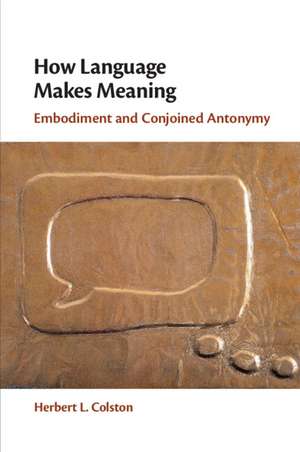How Language Makes Meaning: Embodiment and Conjoined Antonymy
Autor Herbert L. Colstonen Limba Engleză Paperback – 10 aug 2022
| Toate formatele și edițiile | Preț | Express |
|---|---|---|
| Paperback (1) | 203.71 lei 6-8 săpt. | |
| Cambridge University Press – 10 aug 2022 | 203.71 lei 6-8 săpt. | |
| Hardback (1) | 646.19 lei 38-44 zile | |
| Cambridge University Press – 6 noi 2019 | 646.19 lei 38-44 zile |
Preț: 203.71 lei
Nou
Puncte Express: 306
Preț estimativ în valută:
39.01€ • 40.20$ • 32.68£
39.01€ • 40.20$ • 32.68£
Carte tipărită la comandă
Livrare economică 22 februarie-08 martie
Preluare comenzi: 021 569.72.76
Specificații
ISBN-13: 9781009246026
ISBN-10: 100924602X
Pagini: 301
Dimensiuni: 152 x 229 x 16 mm
Greutate: 0.4 kg
Editura: Cambridge University Press
Colecția Cambridge University Press
Locul publicării:Cambridge, United Kingdom
ISBN-10: 100924602X
Pagini: 301
Dimensiuni: 152 x 229 x 16 mm
Greutate: 0.4 kg
Editura: Cambridge University Press
Colecția Cambridge University Press
Locul publicării:Cambridge, United Kingdom
Cuprins
1. The coin toss; 2. Deviance; 3. Omission; 4. Imprecision; 5. Indirectness; 6. Figurativeness; 7. Language play; 8. The social media; 9. The art of language; 10. The end game; Epilogue: a clearing revealing an eclipse; References; Index.
Recenzii
'If you are a linguist, psychologist, or social scientist interested in how language is expanded and manipulated in actual use, this book will enthuse you. With in-depth analyses of real-world conversations, media fragments, and literary texts, the author masterfully shows how figurative, imprecise, indirect, and playful speech shapes communication.' Dirk Geeraerts, Katholieke Universiteit Leuven, Belgium
'This is a marvelous monograph. It convincingly argues that meaning-making is prompted by conjoined antonymous parts. The other key feature of the book is how neurologically driven social motivations intertwine with the functioning of the 'other side of meaning' processes, which arise from the interaction of language with a myriad of mental and social processes.' Angeliki Athanasiadou, Aristotle University of Thessaloniki, Greece
'The renowned cognitive psychologist and linguist Herbert L. Colston shows how meaning is created in language through 'embodied simulations'. Written in a non-technical style and using examples from popular culture or personal anecdotes, this book explains how omission, indirectness, and figurativeness maximize the meaning of what is said by assisting patterns of pragmatic effects.' Linda Thornburg, Co-editor of the book series 'Human Cognitive Processing'
'This book breaks new ground by furnishing familiar models of 'meaning making' with new outfits. It provides a guided tour through the adjacent territories of linguistics and psychology, with abundant examples from current language-in-use. Importantly, the book also builds a bridge between recent experimental psycholinguistic findings and classical semiotic conceptualization.' Jacob L. Mey, Syddansk Universitet
'This is a marvelous monograph. It convincingly argues that meaning-making is prompted by conjoined antonymous parts. The other key feature of the book is how neurologically driven social motivations intertwine with the functioning of the 'other side of meaning' processes, which arise from the interaction of language with a myriad of mental and social processes.' Angeliki Athanasiadou, Aristotle University of Thessaloniki, Greece
'The renowned cognitive psychologist and linguist Herbert L. Colston shows how meaning is created in language through 'embodied simulations'. Written in a non-technical style and using examples from popular culture or personal anecdotes, this book explains how omission, indirectness, and figurativeness maximize the meaning of what is said by assisting patterns of pragmatic effects.' Linda Thornburg, Co-editor of the book series 'Human Cognitive Processing'
'This book breaks new ground by furnishing familiar models of 'meaning making' with new outfits. It provides a guided tour through the adjacent territories of linguistics and psychology, with abundant examples from current language-in-use. Importantly, the book also builds a bridge between recent experimental psycholinguistic findings and classical semiotic conceptualization.' Jacob L. Mey, Syddansk Universitet
Notă biografică
Descriere
Explains the complexities of how language supports human social interaction using the framework of embodied cognition.
